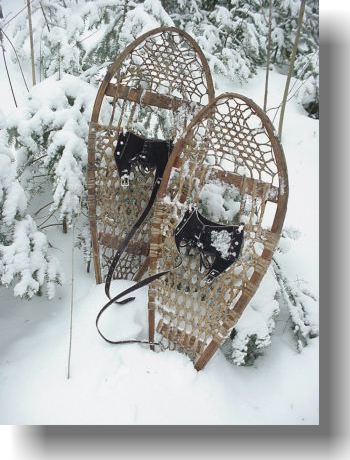So you have decided that you want to start snowshoeing, but don't know where to start. First things first. A little about snowshoeing. A 150 lbs male can burn up to 500 Kcal per hour while snowshoeing at a moderate tempo. Yes, it will or might be cold. Burn about as many calories as running without the impact on your joints. Does that sound goo to you? If so, then snowshoeing might be for you. Can you tolerate the cold well? If not, then snowshoeing might not be for you. You tolerate cold well and you like hiking and taking your time with free will adventure then you just might find that snowshoeing is the activity for you. So you still think that you want to go out and invest in snowshoeing? OK, do you have access to snow? If you are ready then it is time to get your equipment. Here are some helpful hints to make sure that you have the right stuff to make it out on your snowy escapade.

These are not your Grandma's snowshoes
FACT - use this acronym when buying shoes
Floatation - ability to keep the user from sinking in the snow. Depends on snow conditions and weight
Articulation - depends on the binding. Dictates stride, stability and control
Comfort - ergonomics make the snowshoe comfortable by working with your foot's shape. Make sure that the design works for you and that none of the straps are going to place pressure on areas of your foot that might cause discomfort or pain.
Traction - is determined by where you will go

Three questions for buying shoes
- Gender - men's shoes are wider
- Intended use - where will you go
- Totally weight, including body weight, with gear
- What type of shoes will you wear with your snowshoes
- Might be a good idea to try on your snowshoes with your intended footwear
- Will your intended footwear be waterproof, breathe well, and allow for foot warmth?

Clothing
- Your own perception of the environment
- Staying warm and dry
- Think environment of the environmental conditions
- So plan ahead and get the weather forecast
- Waterproof / breathable - want both in cold and wet conditions
- Think the acronym VIP
- Ventilation - your base layer, the layer closest to you body, should be breathable / mid layer should be windproof / outer layer or shell should be waterproof
- Insulation - adding extra clothing or looking for products that will keep you warm
- Protection - top layer or outer layer - Gortex ProShell and PacLight are top of the line items and great products for winter weather sports. To get the best you may have to shell out some cash.
- Head and hands are instant body heat regulators. Look for gloves/headwear that might fit your activity choice and are good at wicking away moisture, but are also good at keeping your natural heat inside.
- Take two hats with you in snowshoeing adventures
- Glove inserts are great for those moments when you need some extra dexterity or to cool off without exposing your hands to the cold air.
- Footware - Gortex or waterproof shoes with a Gator (inner lining) and warm wool socks
- Breathability is determined by personal choice
- What activity are you going to be doing?
- Your shoes should match your plan (ie: running, hiking, long slow escapade)
- DWR (durable water repellant) can wear out over time. Driers will reactivate the repellant. Wash-ins can also reactivate repellents
- Various other products are available
- Get some helpful hint from a reputable sporting authority/store
- Techwash is great for protecting clothing while putting them through the wash cycle

- Fuel for the body
- Snack as you go
- Keep snack light and full of quality macronutrients to help you go that extra mile
- Put on a warmer layer when you stop to eat
- Sitting on your backpack to keep yourself off the snow

Tips
- Use your toes to dig into the snow going up hill
- Snowshoes with heel lifts will make going up hill easier
- Using poles will make it easier for both uphill and downhill
- Find trails using www.alltrails.com
- Find a group class in your area on snowshoeing and participate
- Plan ahead and prepare for winter outdoor safety
- Most of all have fun!!!
- Have lots of fun!
No comments:
Post a Comment